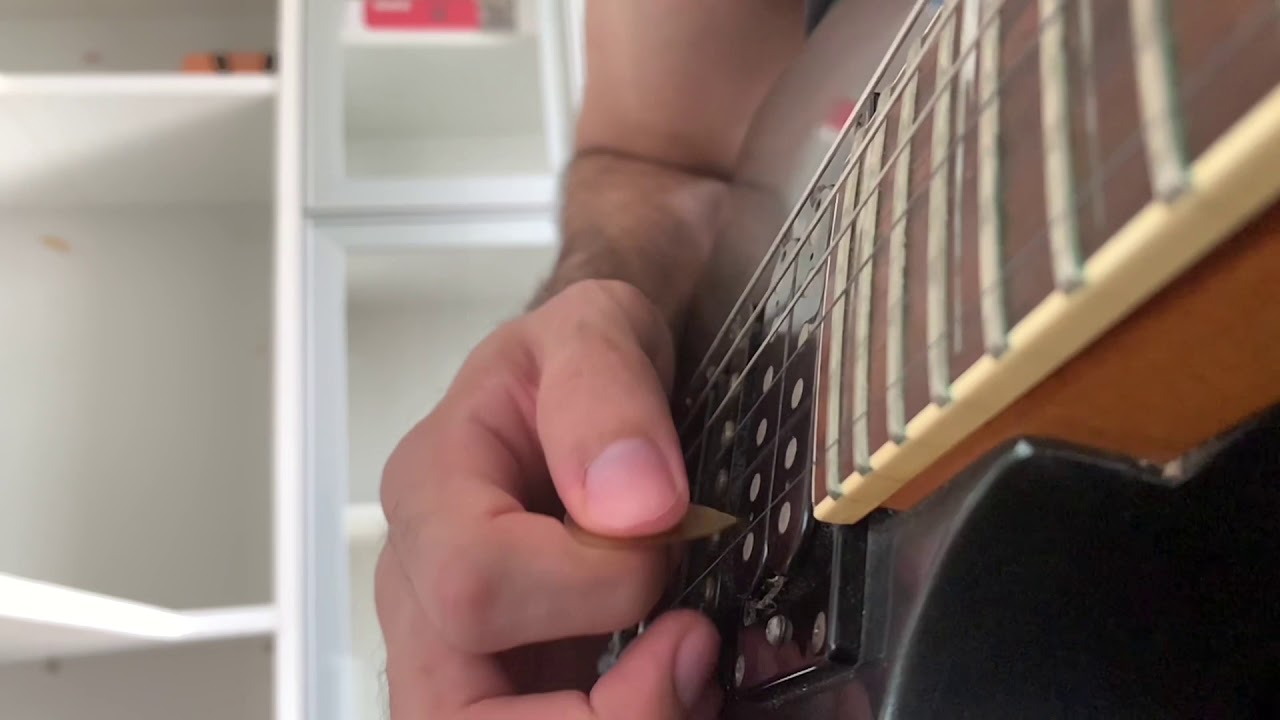Hello to all.
I would like your opinion on my alternate picking technique. I’ve been playing guitar for some time, but i never achieved the level that i thought i would with years of practice, so i kind of gave up from the guitar for a while. Anyway, i’m returning to the instrument now and i’d like you guys to give me some feedback about my alternate picking technique. I’m trying to incorporate the downward pickslanting to it but i feel that there is too much of stringhopping going on (which is one of the things that i feel were holding back my improvement in the early days). Thanks in advance
Wow! Nice accent on the first beat every time, that’s good.
You should have a look at Troy’s picking primer and try all the motions, try using tensing up and using your forearm - good for short speed bursts, and play as fast as you possible can sloppy to get the feel of fast. Try using very tiny movements, try using a lot of gain and/or compression and play super light.
Ultimately you need to experiment and discover what the best relaxed technique is for you.
Oi Edu! Thanks for posting. You are correct, this is a picking motion problem. Notice how your pick hits the string and then goes sideways. It is not making a straight line motion into and out of the strings. Whether this is technically stringhopping or something slightly different, the bottom line is that it is not what you want for very fast smooth playing. You want to make a fast straight-line motion.
The best first step is to test your motions so you can recognize what the correct “straight line” motion feels like. Here is one of our tests which we put on YT:
Take this test and record your metronome number. It should be much faster than this clip. If that is true, then you need to learn to use that kind of motion on the guitar.
I don’t recommend doing either of these things! Tensing up can lead to injury. And we haven’t seen good results on here with the “tiny motions” thing. It mostly seems to result in people playing quiet and stiff.
We do recommend doing this! The simplest approach is to go as fast as possible without thinking about which technique you are using, and see if this produces a more efficient type of motion. You are looking for a motion which feels fast and easy, more similar to the table tests.
Hi Troy,
What about Rusty Cooley, he tenses up his forearm - I did say “short” speed bursts.
Would you not classify Yngwie’s right hand as tiny movements?
Rusty’s technique is a specific type of picking motion which requires one particular forearm muscle to be tensed. It only works for players who use elbow motion, and only if you do it right. I never learned that motion, and tensing up my forearm doesn’t make me any faster than I normally am. It just makes me tired and sore. So I wouldn’t tell a beginner to tense up their arm randomly hoping that it will have a positive effect other than causing unnecessary tension.
Yngwie uses finger motion. These are tiny joints. His motion is never going to look like EVH’s giant tremolo motion, even though Eddie is just as fast. They are simply different forms/techniques which operate differently. So we have to be careful about drawing conclusions from things that look similar because that may just be superficial.
The more practical answer about “small” motions comes from working with students. When we work with players who complain they have trouble playing fast, and we find out they are trying to “be small”, we tell them to stop doing that, and not to think about it and just go for broke. They generally get faster and more comfortable. This has happened enough times now that I don’t think telling someone to try and “be small” produces good results. Note this has nothing to do with whether small motions are good or bad. Instead, it’s just about whether telling someone to try to make a small motion is good teaching advice that produces good results. In our experience that hasn’t worked out.
Your point about going fast without worrying about accuracy is totally on point and backed up by real-world results that we have seen first-hand. That’s really the thing here — observe and test. If a thing works, we keep teaching it. If it doesn’t work, we don’t teach it!
I started with a technique the same as Rusty’s I’ve been playing for 35 years, I later developed a wrist motion as an USX player who accidentally was doing DSX which made sense later thanks to your seminal work. I have never had any issue with injury, however I’ve always taken a break or stopped for the day if there was any persistent pain.
This forearm technique came from brushing my teeth super quick when I was little kid, if you analyse that as a motion you need a decent grip on the tooth brush, hence the tense muscle, and you’re doing it in quick bursts. Still my fastest technique.
I do appreciate you don’t want beginners to injure themselves.
The small motions thing was demonstrated for me by Paul Gilbert, Paul was playing a downstroke and then immediately planting for an upstroke (muting the string) trying to use “tiny motions” I had already been experiment with exactly the same thing, it was interesting to see Paul had the same idea, Michael Angelo also told me about tiny motions with the left hand, I agree, not for beginners, but worth experimenting with once you have a solid technique.
Ask yourself how fast you can play on a steel string acoustic vs an electric with distortion and compression which affords a light touch and doesn’t require loud picking.
I started out playing as fast as I possibly could and also used a metronome and practiced things accurately, it took 10 years to clean thing up and still be fast. Again accidentally a great approach.
How hard it is to get rid of this stringhopping “addiction”? I mean, i know that it’s not a good technique to use in order to play fast, but everytime that i try to use a different kind of technique, it seems that my arm just go straight into it. Do i have to practice the fast alternate picking technique very slow to get my brain to get use to it?


